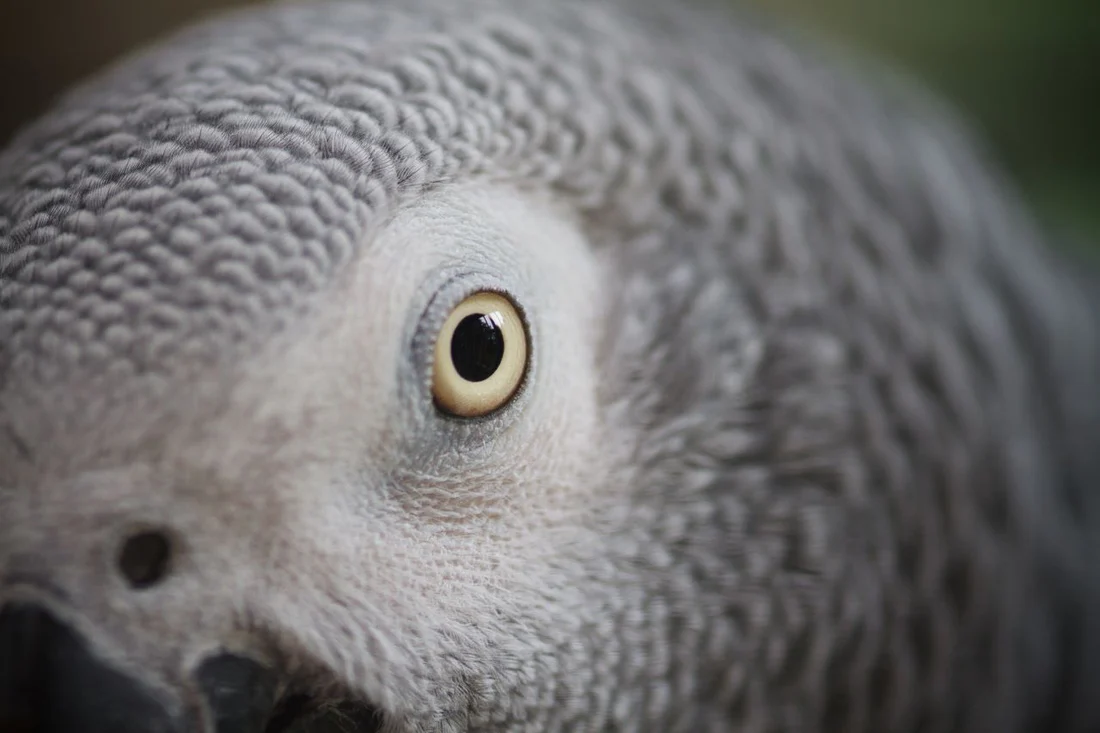
Parrot Eyes Anatomy: All You Need To Know (With Pictures!)
Eyes are body organs specialized for sight. It’s one of the most important senses in parrots. Good eyesight enables safe flight, ability to source for food, identification of threats, and searching for flock mates. Unlike humans who have their eyes in the front, a parrot’s eyes are located on the side of its head. That doesn’t mean they cannot see straight ahead, they can! In this article, let’s find out more about parrot eyes and how they are adapted for our feathered friends.
Monocular Vision
Having their eyes on the sides is a visual adaptation that facilitates flight in parrots because it enhances their field of vision. This means the parrot can see in front as well as the sides. This type of vision is known as monocular vision. In animals, monocular vision refers to the fact that each eye focuses on one object at a time. Both eyes are not dependent on each other.
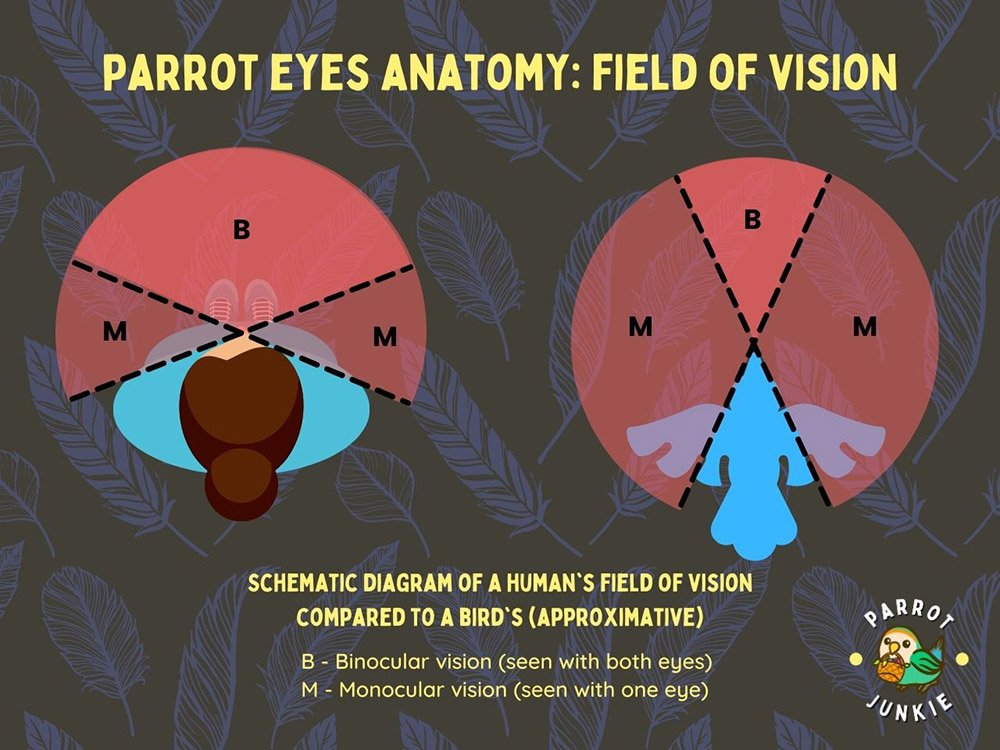
Monocular vision enhances the survival of parrots in the wild since they can be able to see and detect predators way before they can be attacked. Besides, it enables them to change focus rapidly from time to time, having a close to 300 degree view of their environment. They may have a region where they cannot see fully, at the back of their heads, but all they need to do is to twist their heads slightly and they can easily cover that region too.
Vision is the most significant sense to parrots as it enables them to fly safely. They have a specialized visual system that gathers light and works to achieve complex processing of visuals. Unlike humans, parrots have a greater visual acuity. They collect and interpret visual images more quickly than humans. This is possibly the reason why your bird might often notice small movements and changes in its surrounding that you as a human might not notice. If this change or movement makes the bird feel threatened, they might fly away or bite.
Cocking or tilting their heads
While parrots’ eyes give them greater field of vision (they see more things at once), they are not so adept in obtaining depth perception (seeing things in three dimensions and how far away an object is). As a result, you’ll notice them tilting their heads up and down in order to get as much visual information as they can in order to process distance and location. Conversely, birds of prey, such as eagles and owls, have eyes placed toward the front of their heads just like humans, as this is essential for them to focus and locate prey more easily. The narrower the field of vision, the greater the depth perception ability.
In addition to poor depth perception, parrots usually have less developed eye muscles, combined with globular-shaped eyeballs, so they are less able to move their eyeballs around as freely as humans can. This is compensated by the action or cocking and tilting of their heads, as well as having longer and flexible necks, in order for them to collect all the visual information they need.
Parts and Functions of a Parrot Eyes
Parrot’s eyes have many parts that work together to accomplish visual acuity, and keep all the visual structures safe from injury and any kind of infection. These parts include:
- Eyelids and nictitating membrane
- Eyelashes
- Eyeball
- Iris
- Pupil
- Anterior chamber
- Posterior chamber
- Lens
- Retina
- Optic nerve
- Fovea
Eyelids and nictitating membrane
The major function of eyelids in parrots is to protect the cornea from any kind of injury, and keep out foreign bodies and other associated environmental hazards. Eyelids also cover parrot’s eyes during sleep.
Eyelids contain a tough fibrous plate that offers parrots some protection, especially when attacked by predators. Although it doesn’t fully shield the eye from a major blow, eyelids still provide a certain level of protection such that the eye is not directly hit and damaged.
Parrot’s eyes don’t simply block out light even when the parrots are fast asleep. Instead, they ensure that there’s continuous excretion of tears from the lacrimal glands, which keeps the cornea from drying out.
Eyelids also consist of a nictitating membrane (also known as the third eyelid) which is a translucent membrane that stretches fully over the eye in birds. Some mammals such as cats also have a nictitating membrane. Its main purpose is to protect their eyes from water when they put their heads underwater, or to sweep out dust and dirt and keep the eyeball surface moist when flying. The nictitating membrane also serves as a protection to the bird’s eye while maintaining vision when it is feeding chicks, or burrowing its head in places.
The nictitating membrane can be consciously controlled by the bird. Even when the membrane is closed, the bird can usually still see clearly. However, the blinking action of the membrane is often very rapid, so it is not easy to catch it if you’re not looking carefully. While I have often managed to observe Bibi (green-cheeked conure)’s nictitating membranes, I haven’t managed to easily observe Freya’s and Loki’s.
Eyelashes
Probably, you must be wondering whether parrots have eyelashes. Yes, they do; while not all birds have eyelashes, some parrots do. They are similar to humans’ eyelashes where they are hair-like bristles, however they are often much, much thinner and located much more sparsely around the eyelid. It takes a very close-up observation to be able to see a parrot’s eyelashes. Honestly, I had no idea too, till I started bonding with them. The eyelashes protect their eyes from debris when they are flying or burrowing.
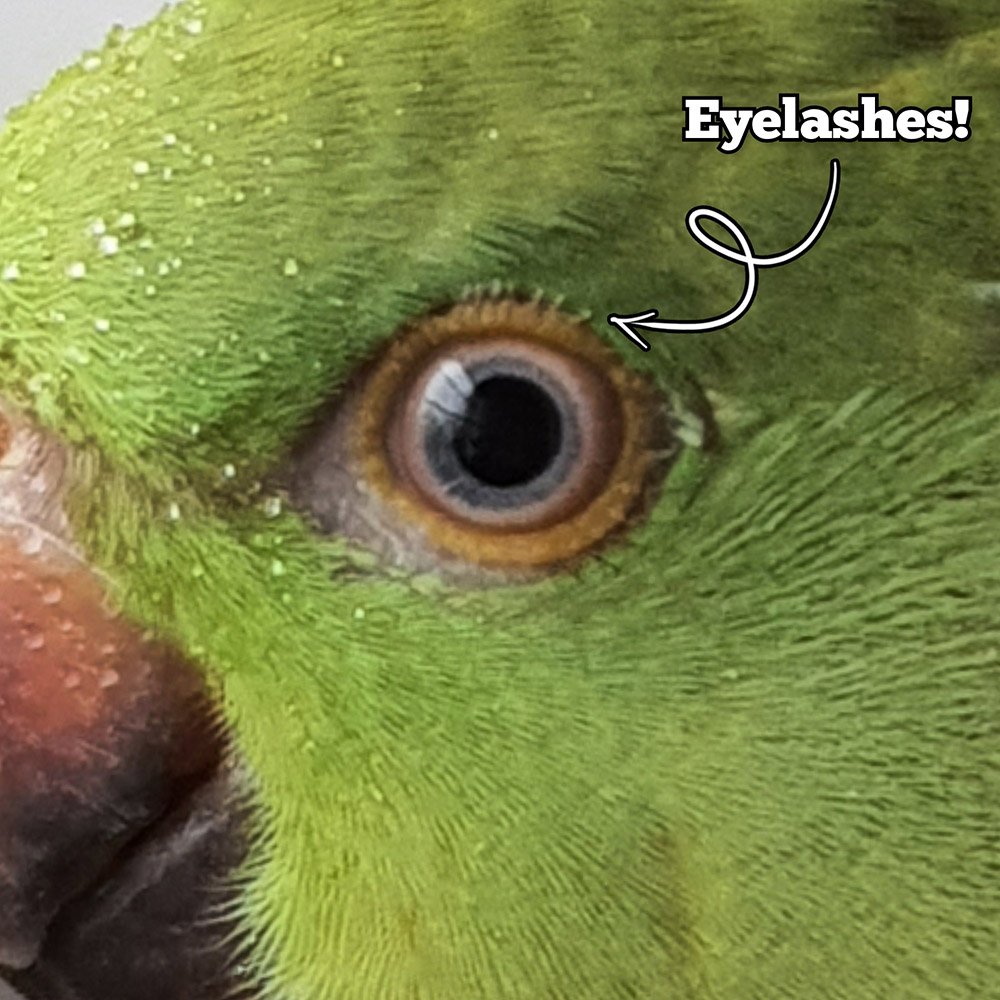
Eyeball
Parrots have eyeballs that are relatively large as compared to the size of their heads. The small anterior cornea makes up the parrot’s eyeball, and it consists of the posterior sclera and scleral ossicles. The scleral ossicles are characterized by tough collagen fibres that help maintain the shape of the cornea and offer protection against changes in pressure.
There are three types of eyeballs that vary across species, namely; tubular, flat, and globular eyeballs. Parrot’s eyeballs are globular-shaped and cannot move around as much as humans who have coordinated eyeball movement. In this sense, they rely on head movement more than eyeball movement to acquire vision, which is why they tilt their heads around to look at things in a better way.
For comparison, humans can rotate their eyeballs about 50 degrees horizontally, however, most birds can only do so at about 20 degrees.
Iris
The iris is the colored part of a parrot’s eye that is around the pupil. It helps control and maintain the amount of light entering the eye. If you look closely at parrot eyes, you will find a wide variety of colors! Some parrots’ eye colors are correlated to their genders – for example, in cockatoos, females have brown irises while male cockatoos have black ones.
The iris has a sphincter muscle that allows controlled expansion and constriction of the pupil in order to control the amount of light eyes receive. It constricts the pupil whenever there’s bright light to allow less light through. It opens up the pupil in low light conditions, to let in more.
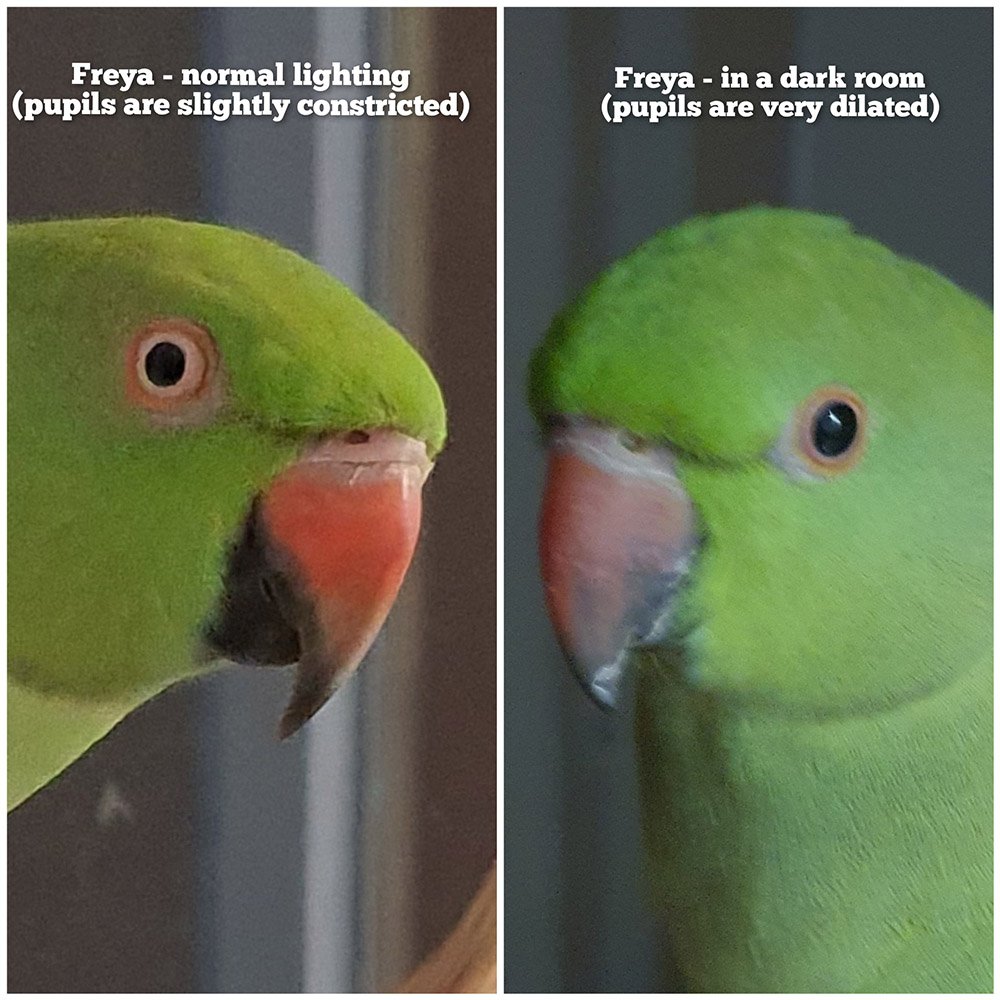
Some parrots’ irises change color as they mature. For example, in some varieties of Indian ringneck parakeets, budgies, or African grey parrots, their eyes look totally dark in color when they are babies. As they grow older, their iris changes to white, resulting in the formation of a ring appearance known as the “iris ring”. This can be one of the determining factors of a parrot’s age – for instance, ringnecks’ iris rings gradually lighten when they are around 4-6 months old.
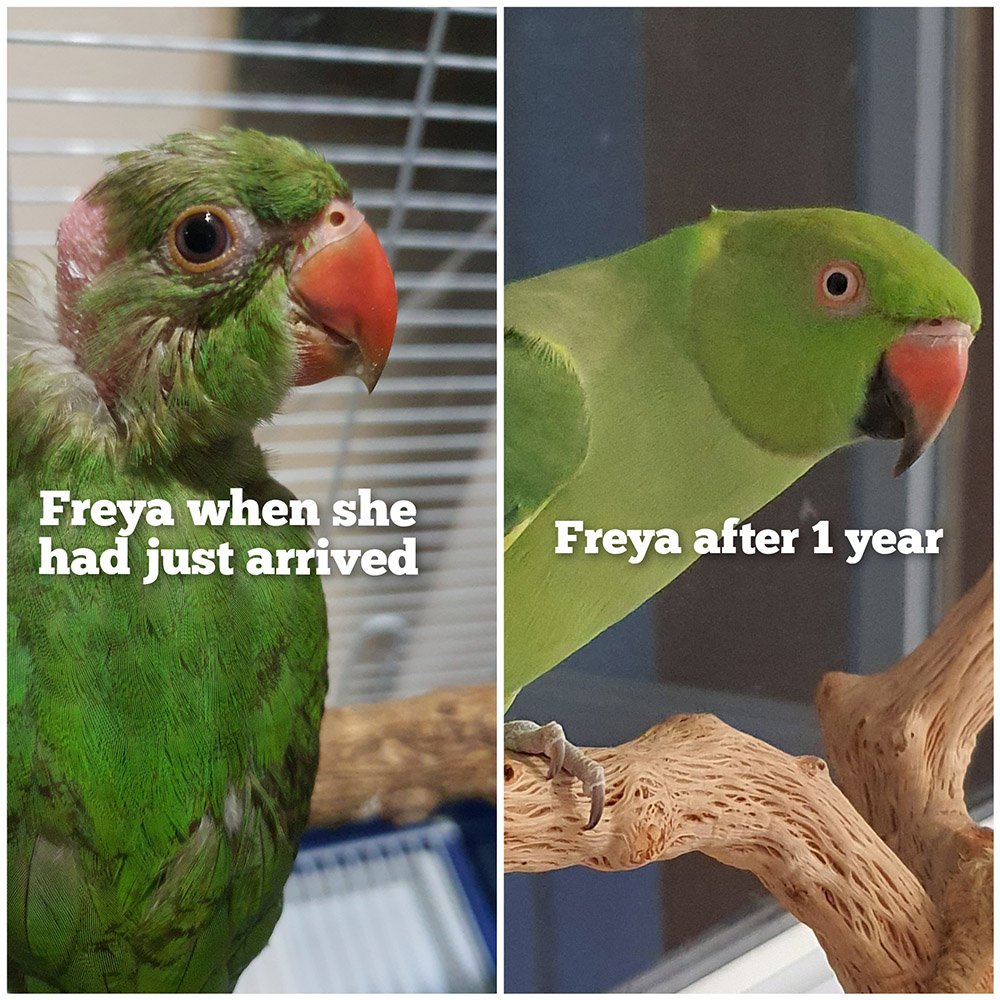
Pupil
The pupil is the variable circular area surrounded by the iris that regulates the amount of light entering the eye. It expands and constricts to control level of light entering the eye, according to the controlled movement of the iris’ muscles. Parrot’s eyes are prone to stimuli in their environments. Therefore, they often reacting to it, resulting in eye pinning.
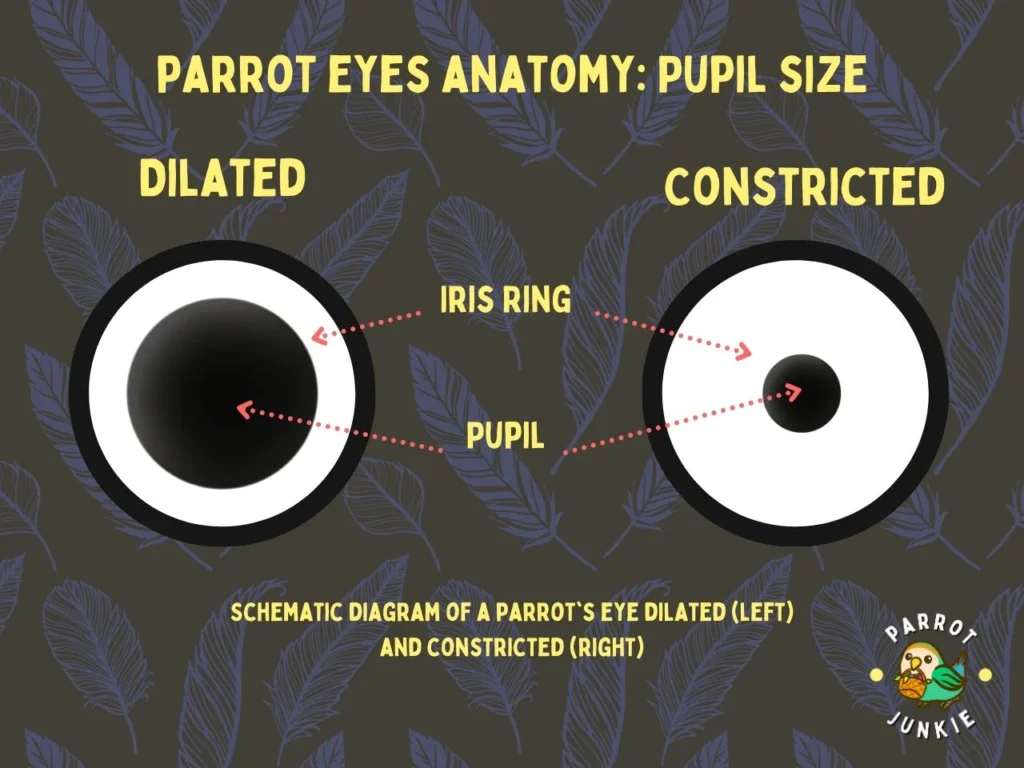
Parrot eye pinning or eye flashing is a type of body language common in pet parrot species. It’s a rapid dilation and constriction of the pupil in response to external stimuli. It may be an indication of parrot’s anger, anxiety, excitement, or curiosity. So, you will be able to tell your parrot’s mood by simply checking on his eye pinning behaviors. Besides, some parrots like the Panama amazon do so when they are trying to communicate with their owners.
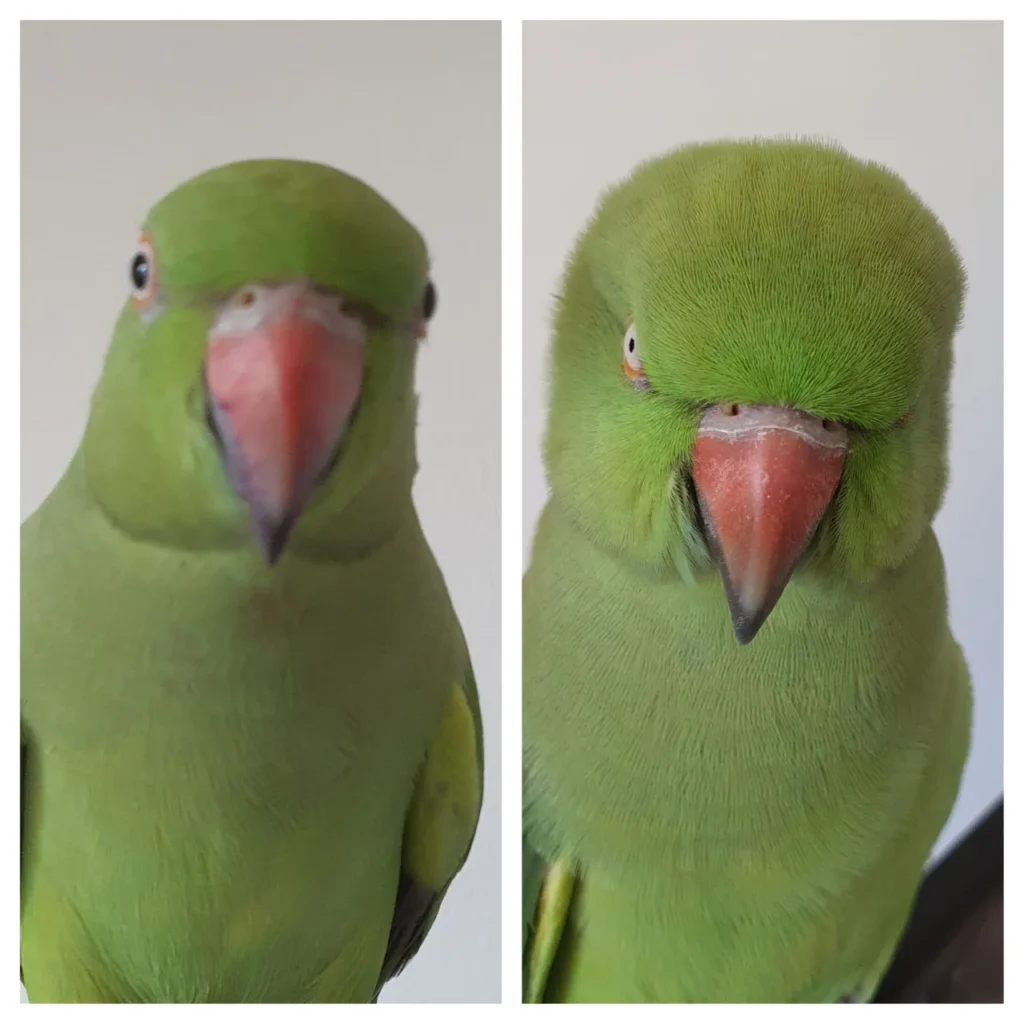
If you are new to your bird, it may take a while for you to determine whether your parrot’s eye pinning is due to feeling threatened or feeling excited. Contextual information is very important, meaning to say, the situation combined with a variety of other observations (in addition to eye pinning), contributes to the overall assessment of your parrot’s mood. You should observe your parrot carefully to learn its body language.
The Anterior and Posterior Chambers
The anterior chamber of parrot’s eye is filled with aqueous fluid that lies between the cornea and iris. The fluid helps the eyes to focus and form an image through constant refraction of light. Besides, it removes contaminants that may cloud the vision.
The posterior chamber is the area between the lens and iris that is filled with aqueous fluid. It helps complete the work of focusing light on an object. The fluid has to drain continuously otherwise it may damage some parts of the eyes leading to vision complications such as glaucoma, caused by the build-up of pressure in the posterior chamber.
Lens
Parrots have softer lens than us human beings, and are located behind the pupil. The normal lens of a parrot appears clear and colorless. They perform the final focusing of the light. They have ciliary muscles attached to it to slightly modify its shape in order to focus light properly. Lens enables parrots to visualize so many things that humans cannot see since it filters up to lights below 350 nm (ultraviolet wavelength) whereas humans’ eyes can filter only down to 400 nm. This makes it possible for parrots to distinguish ultraviolet lights.
This ability results in them being able to detect ripeness in food, perceive male versus female birds, and identify display feathers from potential mates, that are otherwise indistinguishable to human eyes. For example, budgies have been found to have fluorescent feathers that are only perceivable under UV light (see image below) – this fluorescence is something humans cannot see in normal lighting. It makes one wonder how much more amazing our feathered friends would look if only we could also see the UV spectrum!
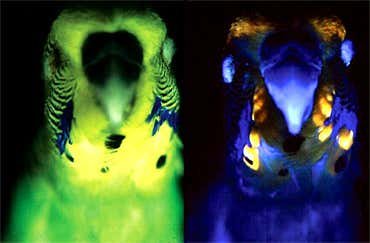
Retina
The retina is a tissue layer that covers the back of the innermost eyeball and is very sensitive to light. It contains light-sensitive cells namely; rods, cones, and ganglion, that respond to light and help to distinguish between colors. These cells send messages to the brain upon stimulation; whereby the visual centers turn them into actual images.
While rods are mainly responsible for the intensity of light that enters into the eyes, cones are in charge of color vision and visual acuity. Parrots’ visual acuity is estimated to be around 2 to 8 times greater than of other mammals. That’s why parrots can see a wider range of colors and they have the ability to distinguish many of them as opposed to humans. Birds generally also have five types of cones, consisting of four single cones contributing to tetrachromatic color vision (humans have only three – blue, green and red), and one double cone that is believed to help in achromatic motion perception.
Optic Nerve
Optic nerves are a bundle of nerve fibers that transmit sensory information from the retina to the brain. It’s the main sole output of information. It’s the only way parrots can be able to identify images and other objects in their environment. Any damage to the optic nerves can lead the parrot to permanent blindness even if the whole eye looks fine.
Fovea
Parrots have two fovea per eye that functions separately and are located in the inner surface of the retina. It’s full of cone photoreceptors as it’s responsible for high-acuity vision. It provides the clearest vision of all and enables parrots to focus on one image at a time. Humans, on the other hand, have only one fovea in each eye.
Final Notes
Parrot’s eyes are well adapted for great distance of vision, excellent visual acuity, wider visual field, and low light. Understanding parrot’s eye anatomy gives you an opportunity to improve your understanding of their behavior as well. You can be able to learn your bird’s movements and general body language by looking at patterns in your bird’s responses to external stimuli. Some common behavioral displays such as eye pinning acts as a tool that enables you to communicate well with your bird. It is always good to know more about parrots’ eye anatomy to understand your bird better!
References
Carpenter, J. A. (2019). Neurobiology and communication in parrots with an emphasis on eye signaling (Doctoral dissertation, uniwien).
Faillace, A. C. L., Vieira, K. R. A., & Santana, M. I. S. (2021). Computed tomographic and gross anatomy of the head of the blue‐fronted Amazon parrot (Amazona aestiva). Anatomia, Histologia, Embryologia, 50(1), 192-205.
Pecora, R. A., Watanabe, S. S., Brito Guimarães, M., Otsuki, D. A., de Moraes Barros, P. S., & de Mendonça Vaz Safatle, A. (2020). Applicability of optical coherence tomography in blue‐fronted parrots (Amazona aestiva). Veterinary ophthalmology, 23(2), 358-367.
Parrot Junkie www.parrotjunkie.com
Copyright © 2021-2024. All rights reserved.

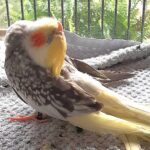
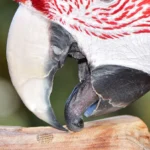
Pingback:
23 Signs Your Parrot Trusts and Likes You - Parrot Junkie